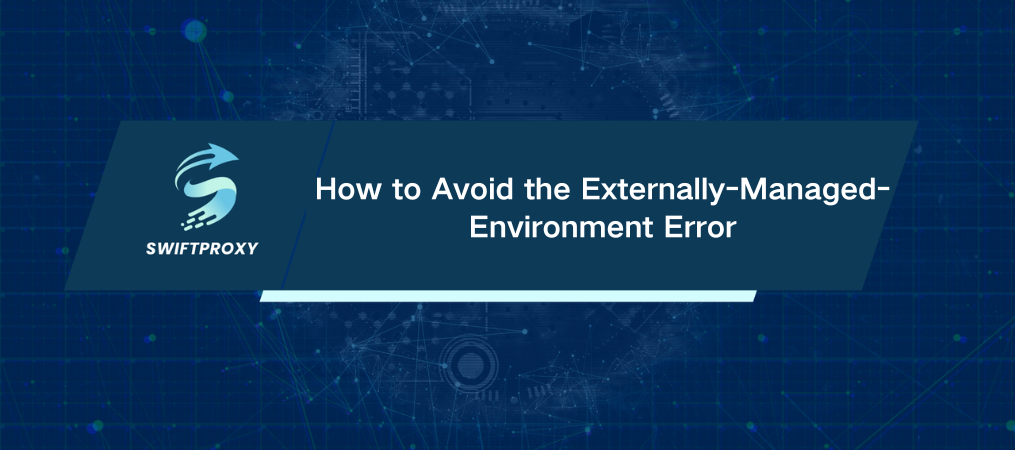How to Avoid the Externally-Managed-Environment Error

You've been coding away, trying to install a new Python package with pip, when—boom—this annoying error message pops up: "Externally-managed-environment." It's like you're trying to hang a picture in your apartment, but your landlord shows up and says, "Nope, you can't touch the walls." What's going on?
Simply put, this error occurs when you're trying to install a Python package in an environment that is controlled by something outside of Python—like your operating system's package manager. The system is trying to protect itself, and pip's attempts to modify things could break something important. So, how do you fix it without ruining the whole system? Let's dive in.
The Overview of the "Externally-Managed-Environment" Error
This error happens when your Python environment is being managed by an external tool or package manager. It's a safeguard. The environment is locked down to prevent conflicts between system-wide packages and Python packages. When you try to install something via pip, the system tells you, "No can do," because it doesn't want you accidentally breaking something crucial.
This typically happens on Linux distributions like Fedora or Debian, where Python is pre-installed by the system. If you try to install packages globally with pip, they might overwrite or clash with system libraries. Worse, uninstalling or upgrading a package could break your system entirely.
The "externally-managed-environment" error is simply Python saying, "You can't touch that!" Now, let's look at how to get around it.
Why Does This Happen
Some systems lock down Python installations to maintain stability. Linux distributions, for example, bundle Python with their core system, and messing with it could cause all kinds of headaches. If you install a package globally, you might unknowingly cause conflicts between the Python environment and the operating system's tools. This could even render your system unstable.
The key issue is that your Python environment is marked as "externally managed." So pip has been instructed to stay out of it. It's like the system is saying, "You can't play in this sandbox without supervision."
How to Resolve the "Externally-Managed-Environment" Error
If you're getting this error, there are a few ways to sidestep it and install your Python packages without triggering chaos.
1. Create and Use a Virtual Environment
The most common—and safest—solution is to create a virtual environment. Think of it as creating a personal, isolated "sandbox" where you can freely install whatever you need, without touching the global system environment.
Here's how you can do it:
Install venv: Some systems don't have venv installed by default. To get it, run:
On Debian/Ubuntu:
sudo apt-get install python3-venv
Create a Virtual Environment: Navigate to your project directory and set up a new environment:
python3 -m venv envname
Activate the Virtual Environment: This will switch you into the isolated environment:
On Linux/macOS:
source envname/bin/activate
On Windows:
envname\Scripts\activate
Install Your Package: Now you can install your Python package without any restrictions:
pip install requests
Deactivate the Virtual Environment: Once you're done, exit the virtual environment by running:
deactivate
With this method, you're in the clear. Your system's Python remains untouched, and your project gets exactly what it needs.
2. Utilize the System's Package Manager
If you're working with a managed environment, it might be easier to go with the flow and use the system's package manager. This keeps everything consistent and minimizes the chance of causing a conflict.
Identify Your Package Manager: Different systems use different tools:
Debian-based (Ubuntu, etc.): apt
Red Hat-based (Fedora, CentOS, etc.): yum or dnf
macOS: brew
Update the Package List: Make sure your package manager has the latest info on available packages:
On Debian/Ubuntu:
sudo apt-get update
Search for Your Package: Before installing, check if it's available in the system's repository:
On Debian/Ubuntu:
apt-cache search <package_name>
Install the Package: Use the appropriate command for your system. For example, to install requests:
On Debian/Ubuntu:
sudo apt-get install python3-requests
On Fedora/CentOS:
sudo yum install python3-requests
On macOS:
brew install requests
This method ensures compatibility with your system and avoids the "externally-managed-environment" error altogether.
3. Force Installation with Caution
If you really need to install a package and you're feeling brave, you can try bypassing the restrictions with pip. But proceed with caution—this could potentially cause issues with your system's Python environment.
Here's how to do it:
Use --break-system-packages: This tells pip to ignore the environment restrictions:
pip install <package_name> --break-system-packages
Install for the User Only: This installs the package to your user’s site directory, avoiding the global Python environment:
pip install --user <package_name>
Use --ignore-installed: This option tells pip to install the package even if it's already installed:
pip install --ignore-installed --user <package_name>
Combine with sudo (use as a last resort):
sudo pip install <package_name> --ignore-installed
Again, be careful. Force installing can lead to a broken environment if you're not careful, so it's better to use virtual environments or stick with the system package manager whenever possible.
In Summary
The "externally-managed-environment" error happens when the environment is externally managed, and you're trying to install packages in a Python environment that's managed by an external source, like your OS's package manager. This is the system's way of protecting itself from potential conflicts or issues.
To fix it, you can either use a virtual environment to isolate your package installations, which is the safest and most sustainable approach, or install via the system's package manager to ensure compatibility. If absolutely necessary, you can force the installation, but be cautious of the risks involved. Additionally, using a proxy when setting up or downloading packages can help you bypass network restrictions or throttling, ensuring a smoother installation process. The first two options are by far the best methods to handle Python packages safely.

















































